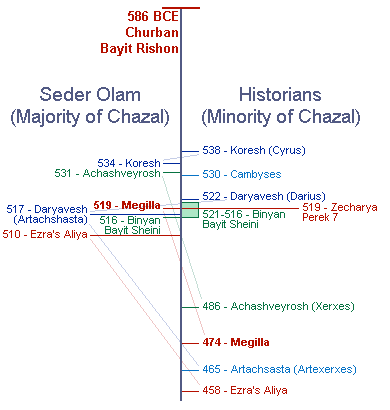Mishloah Manot
Found 4 Search results
Stages of Acceptance of the Festival
Chapter 9
Prof. Jonathan GrossmanThe detailed description of the process leading to the acceptance of Purim as a chag attests to the need to convince the public. Will Purim be celebrated on the 14th or 15th of Adar? How should the day be marked and celebrated? We will examine the various stages of accepting the holiday as described in the Megillah.
Megillat Esther and Sefer Zekharya
Rabbi Menachem Leibtag
According to the chronology posited by Seder Olam, Ahashveyrosh was the king immediately after Cyrus but before Darius, and the story of Megillat Esther immediately led to the building of the second Beit HaMikdash and a mass Aliya. However, according to the common historical approach Ahashverosh was the king who succeeded Darius. The Beit HaMikdash was already built and two decades pass before any new Aliya movement. In fact, no major event takes place immediately after the events in Megillat Esther. However, parallels between Megillat Esther and the prophecies of Zekharya imply that the initiators of the holiday of Purim understood that the ultimate success of the Return to Zion and the rebuilding of the Beit HaMikdash depended on the implementation of social Mitzvot.
The First of the Seventh Month - Rosh HaShana in Tanakh
Elisheva BraunerThe Teshuva Revolution
Part 2
Rabbi Tzvi SinenskyConsistent with the transition detailed from a Temple-based Judaism to a Torah-centered lifestyle, the emphasis in this chapter is decidedly not on the Temple service. Many, if not all, of the practices omitted in this chapter bear significant connections to the Temple service. Ezra’s revolution, which seeks to reimagine Jewish life in the aftermath of the destruction of the First Commonwealth, envisions an observance of the holidays that does not revolve around the sacrificial service.
Putting Esther and Nehemya together, it appears that repairing the Jewish People’s social fabric was a major point of emphasis for both post-exilic communities. It is almost as if Tanakh implies that Jews of Persia and Israel sought to “undo” the sins of previous generations, in which the wealthy trampled upon the poor and there were irreparable divisions between the different classes of society. Both Esther and Nehemya worked to create greater unity by emphasizing the importance of generosity at times of communal celebration, so that no one would feel excluded.
The extraordinary moment of solidarity around the celebration of Sukkot – with all the difficulties it raises regarding contemporary observance of that holiday - coupled with the dramatic impact of the Torah reading ceremony just a few days earlier, combines to make the events of Nehemya chapter eight some of the most climactic known to biblical history.

